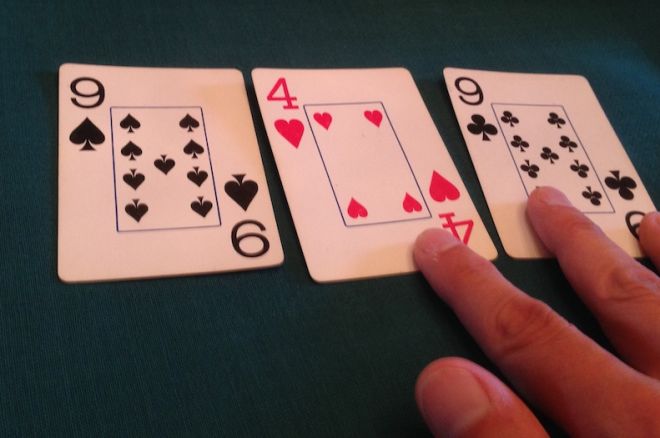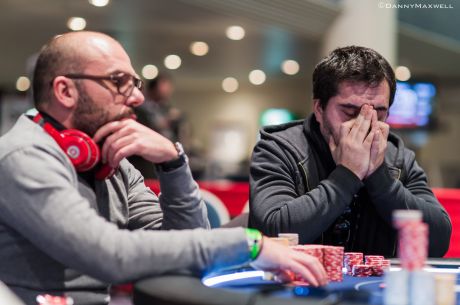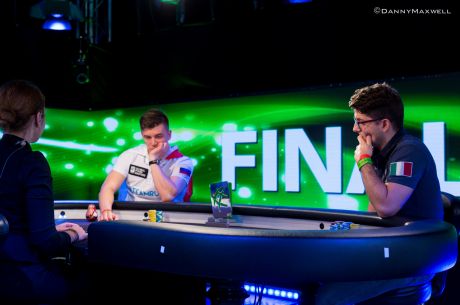When a Pair Falls on the Flop: Fire Away or Control the Pot?

The ��way ahead/way behind�� situation is a fairly common one in no-limit hold��em. Novice players fearing opponents holding the strongest possible hands against them might think being way ahead or way behind happens more often than it actually does. But those with more experience readily recognize those occasions when the betting action, board texture, and other factors add up to such scenarios.
Sometimes a preflop raising war between two players can suggest to one of them �� say, the one holding K?K? who suspects his opponent can only have pocket aces or ace-king �� that he��s either way ahead or way behind. More often, though, the ��way ahead/way behind�� idea comes up postflop, such as when that same player with pocket kings sees a A?8?3? flop fall when up against a single raise-calling opponent.
In the latter example, the player with pocket kings is going to enjoy around a 9-to-1 edge versus most hands not containing an ace (not counting pocket eights, pocket treys, or eight-trey, of course). Meanwhile versus a player holding AxXx, he will be behind by even more than 9-to-1.
The Paired Flop
Another familiar spot in NLHE that is often characterized as a ��way ahead/way behind�� situation occurs when a pair appears on the flop, particularly when no flush or straight draws are present. A pair actually comes on the flop about 1 out of every 6 times in hold��em, making it a situation that occurs often enough it is probably worth giving a little extra thought to how best to play it.
Say you open from late position with A?J? and get called by the big blind. The flop comes 9?4?9? and your opponent checks. How do you proceed?
A continuation bet is certainly in order here, given that (1) you think your opponent likely missed the flop, (2) you know you��ve missed the flop, and (3) you have the initiative in the hand. You fire away, but your opponent calls. The turn then brings the 7? and another check from the big blind. Now what?
The odds of a player with two unpaired hole cards flopping trips are about 1 in 73. Of course, when a player check-calls a bet after that flop, you might be encouraged to increase the chance he did in fact flop trip nines. And if you bet again here on the turn and your opponent calls once more, it might seem even more likely that he has, or at least that he holds a pocket pair or some other hand that can beat the two unpaired Broadway cards you are holding.
In the first volume of Harrington on Cash Games, Dan Harrington and Bill Robertie advise those in such a spot to practice pot control. ��If you��re in a way ahead/way behind situation and you believe you could equally well be either ahead or behind, you don��t have much reason to get more money in the pot,�� they write. ��Bets will be called by hands that beat you and folded by most hands that are clearly weaker, so betting doesn��t rate to gain much and can just be a lost bet if your opponent is in a position to know he��s winning.��
Meanwhile Daniel Negreanu in his More Hold��em Wisdom for All Players discusses the value of bluffing at paired flops. He carries the reader through an interesting televised hand between a player holding Q?9? raising, another with 9?7? defending his blind, and the flop coming 10?10?5?. When checked to the first player bet, the player in the blind check-raised, then the original bettor reraised back. In other words, both players were bluffing away, each having picked up on weakness in one another in what Negreanu considered ��a stellar demonstration of poker at an elite level.��
While both Harrington/Robertie and Negreanu were addressing NLHE as it was played several years ago, their respective advice regarding paired flops and the ��way ahead/way behind�� situation remains applicable. Speaking in general terms, players today might be relatively more willing to bluff at paired flops than in the past, but every game plays differently which means player reads ultimately dictate the best approach to take. In some games most players may instinctively shy away from getting too involved when there is a pair on an otherwise dry board, while in others players might look upon that as an opportunity to go battle.
Conclusion
In your next NLHE cash game session, make note when paired flops occur and watch how your opponents respond when they do. Many players will exhibit a kind of ��default�� response to the paired flop, only diverging from it on those exceedingly rare occasions when it has in fact hit their hand.
Negreanu recommends mixing up your play when it comes to paired flops, pointing out that ��if you fall into any pattern, bluffing or not, it won��t take long for opponents to pick up on it.�� But many players don��t heed such advice, always choosing one approach or the other (caution or aggression). Pick up on their patterns, and you��ll be the one benefiting more often from those frequently-occurring paired flops.
Get all the latest PokerNews updates on your social media outlets. Follow us on Twitter and find us on both Facebook and Google+!








